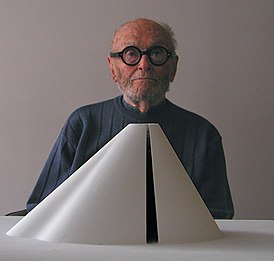Was born on 8 July into the family of a lawyer. From childhood he was fond of architecture. Studied history and philosophy at Harvard. Then he worked as a critic, writer, architectural historian, museum director, was engaged in politics and journalism.
1906 - 2005
Philip Johnson

description
Philip Johnson was an American architect, founder and leading representative of the “international style” in mid-twentieth century American architecture. The Founding Father of American Postmodernism. Laureate of the first Pritzker Prize (1979). Mendini called Philip Johnson “the last architect of the era of the masters and the first of the era without masters.” His work is intellectual rather than intuitive. Along with the importance of history, Johnson asserts architecture as a great art, albeit an art of form. His views were shaped by the work of Mies van der Rohe. Johnson perceives structural purity and classical symmetry of plans, asceticism in the use of architectural tools and careful attention to detail. Breaking with Mies, Johnson goes through a period of sophisticated classicism, through monumental imperial classicism and “free historicism” with an unparalleled combination of forms. Johnson is different not only in different periods of his life, not only in the choice of sources, but also within each work. He combines symmetry and asymmetry, references to Corbusier, Mies, van Doesburg, Malevich, Ledoux, Schinkel. This is due to his multilayered education as a historian and philologist.
Main works:
1) Glass House, 1949;
2) Sculpture Garden of the Museum of Modern Art, New York, 1953;
3) Seagram Building, New York, 1958;
4) Monastery of St. Anselma, Washington, 1960;
5) Roofless Church New Harmony, Indiana 1960;
6) Museum of Western Art in Fort Worth, Texas, 1961;
7) Museum of Pre-Columbian Art in Washington, 1963;
8) Lincoln Center, New York, 1964;
9) Kunsthalle in Bielefeld, Germany, 1968;
10) Williams Tower, 1983;
11) American Central Bank, Houston, Texas, 1983;
12) AT & Τ (Sony Building), 1984;
13) PPG Building, Pittsburgh, 1984;
14) Lipstick Building, New York, 1986;
15) Crystal Cathedral in Gardengrove, California. Cathedral, 1980; and tower, 1990;
16) 191 Peachtree Tower, 1990 – 1991;
17) Chapel of St. Basil at the University of St. Thomas, Houston, 1992;
18) One Atlantic Center, 1992;
19) One Detroit Center, Detroit, 1993;
20) Gateway to Europe, Madrid, 1996
21) Millennia Retail Gallery, Singapore, 1996;
22) Trump International Hotel and Tower, New York, 1996;
23) St. Baril Chapel Houston, TX, 1996;
24) MoMA Museum of Contemporary Art, New York, 2004.
Key ideas
– An adherent of pure geometric shapes and designs in steel and glass.
– His work is more intellectual than intuitive activity.
– Along with the importance of history, Johnson affirms architecture as a great art, though primarily as an art of form.
– Johnson was not a supporter of any one architectural style. It was never too late for him to start over.
1906
1928
1940
1956
Late 1960s
1980s
Was born into the family of a lawyer
Became a student of L. Mies van der Rohe
Became a student of L. Mies van der Rohe. Was appointed Director of the Architecture Department of the Museum of Modern Art in New York. There, at the age of 26, he was the curator of the exhibition “Contemporary Architecture”, in which V. Gropius and Mies van der Rohe, who moved to the USA after the closure of the Bauhaus, took part. The fact that the exhibitors were from different countries became the reason for the name of the new architectural style. It provided the possibility of free planning and lighter, independent facades. Geometric volumes, correct proportions, rhythm of structural elements, rigor of composition and new materials were proposed instead of ornaments for decorating structures.
Enters Harvard and receives an architectural education
Enters Harvard and receives an architectural education. Designs his own home for his master’s degree in architecture.
He was one of the authors of the Seagram Building
He was one of the authors of the Seagram Building, which became an icon of the modernist office building.
A dramatic change in Johnson's outlook
A dramatic change in Johnson’s outlook. In his sketch for “Seven Crutches of Architecture,” he proclaims, “My direction is clear – an eclectic tradition. This is not an Academic Renaissance. This is not a classical order or Gothic phials. I try to choose everything I like about history. You must know history.” Johnson’s historicism remained at the level of source designation; it never developed into ornament, regional relevance, or contextuality. Historical motives were not just indicated, they were fused into certain new wholes with high professional culture and skill. He noted that American megalomania is the main reason for the rise of the “skyscraper school”. It is a fact of national pride that Americans build thousands of pounds of houses just as easily as other civilizations built houses of hundreds of pounds.
Johnson with John Burgey built several objects that became their "calling card"
Johnson with John Burgey built several objects that became their “calling card”. The Johnson and Burgey firm became the mouthpiece of further architectural fashion for American architecture.
